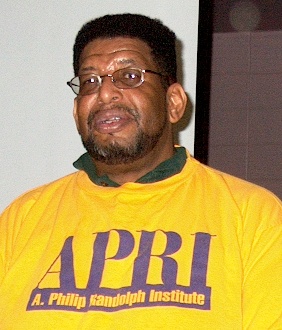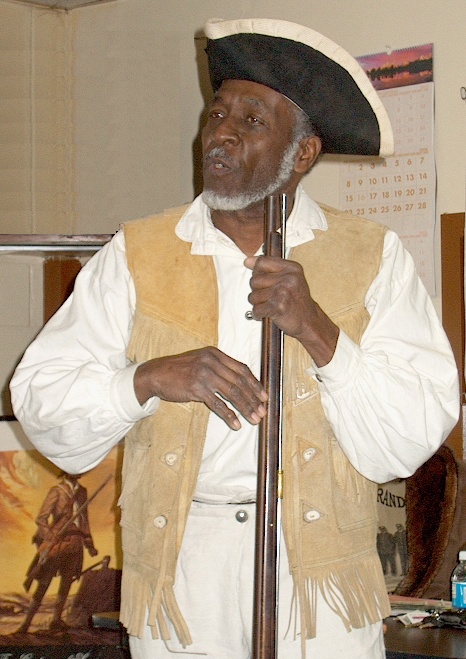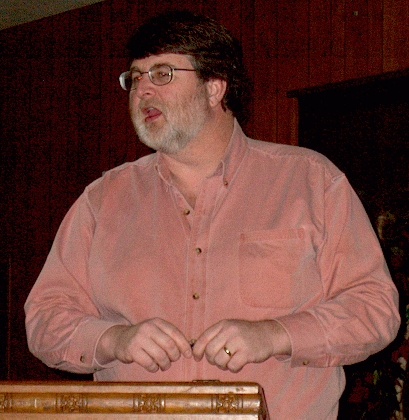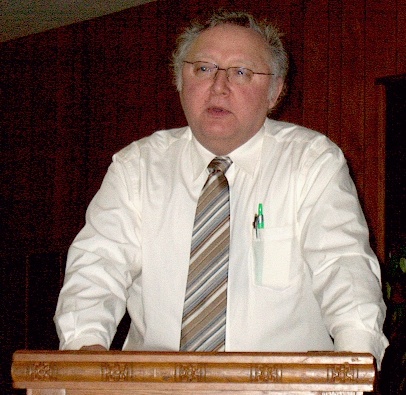Black Patriots in the American Revolution
This three-part program was organized by the A. Phillip Randolph Instituteof Delaware (APRI-DE)and the Washington-Rochambeau Revolutionary Route
Association of Delaware (W3R-DE) and presented on 2006 Feb 11.
(This summary is by Ralph Nelson, Delaware Society SAR)
Note: While recognizing that there are problems inherent
in any group terminology for a characteristic that is not uniform
for the entire group, this article will use the term "black" to signify
anyone in 1775-1790 whose color indicated significant African ancestry,
#1 -- Black Patriots of the RevolutionThe morning program was held at Longshoreman's Hall as the monthly education program of the A. Phillip Randolph Institute of Delaware. APRI president Marietta Whalen welcomed the members and guests. Mark Brunswick (above), Education Director for APRI-DE and a director of the W3R-DE, introduced Willis Phelps (below), a veteran re-enactor of Civil War and Revolutionary War soldiers.
Dressed in the uniform of a Revolutionary War militiaman, Mr. Phelps described the hardships faced by black soldiers during the Revolution and several campaigns (Rhode Island, siege of New York) in which their presence was critical to the success of the U.S. cause. #2 -- Black Partipants Were Numerous and SignificantThe afternoon program was held at the Ezion - Mt. Carmel United Methodist Church in Wilmington.
New Castle County Councilman John Cartier (above, left) introduced Dr. Robert Selig (above, right), a historian who has done research on black participation in both the U.S. and European armies during 1750-1850. Because they made up 20 percent of the population blacks were a significant economic and military resource in the rebelling colonies, and both sides sought both to enlist their services and to deny them to the enemy. However, neither of the two sides had a goal of emancipating slaves. For the U.S. patriots the goal was to re-establish the historical right of British men to self-governance through elected legislators. This goal was achieved. Throughout the Revolution, the issue of emancipation was raised and generally recognized as a desirable goal, but the legal and social changes required to implement it were defered. Both the British and the U.S. offered freedom only to slaves who escaped from the other side. Thus, the British did not set free the slaves of Loyalists, and the U.S. did not set free the slaves of U.S. patriots. Many of the slaves who escaped to the opposite side discovered that the promised freedom was not granted, and they continued to be enslaved. As the U.S. grew more desperate for recruits, it first allowed and later encouraged the enlistment of free blacks and of slaves who served as substitutes for their masters (who got the enlistment bounty and pay), as well as escaped Loyalist slaves who enlisted "for the duration" in exchange for being granted freedom at the end of the war -- only, of course, if the U.S. won. Dr. Selig specified many units (U.S, French, British, and Hessian) in which blacks were enlisted, and noted many other important activities through which blacks supported the rebels or the crown during the American Revolution. Specific units with numerous black troops included:
Delaware's black patriots in the Revolution include
#3 -- Billy Lee, George Washington's Loyal ServantBilly Lee became the personal slave of George Washington when Washington was age eleven and remained with him until Washington died. Throughout the eight years that Washington served as Commander-in-chief of the Continental Army, Lee was at his side -- both in camp and in battle. Col. George Washington Parke Custis wrote a book based on his interviews with Billy Lee after President Washington's death.Dr. Ralph Nelson, Historian for the Delaware Society of the Sons of the American Revolution (SAR), played the role of Col. Custis interviewing Billy Lee. Dr. C. Lawler Rogers, Director of the HildaMan Chorus, told the life story of Billy Lee. Dr. Rogers sang two songs from the musical "Billy Lee's George Washington", by Evelyn Swensson, which will be performed on September 30, 2006, as part of the Delaware commemoration of the march to Yorktown of the allied U.S.-French armies under Generals Washington and Rochambeau. The allied force passed through and camped in Delaware going south in 1781. |


